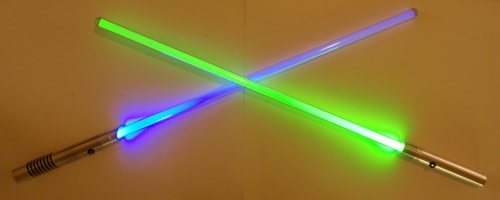
I am definitely a child of the 70’s and 80’s. As such, I was (and remain) a pretty huge Star Wars fan. I remember my father taking the day off for the first Star Wars movie, not going to school, and standing in line to see the very first showing of Star Wars at the Cinerama 150 in downtown Seattle. From that moment, I lived and breathed Star Wars for years as a kid. I had a ton of Star Wars toys during that time period….from the trading cards to the figures to the cheesy lightsaber they had out at the time. Back in the day, the best lightsaber available was a painted flashlight with a plastic balloon you had to keep blowing up, the end flopped around, fell off, no sound, etc.
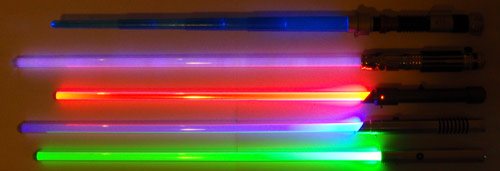
Well, lightsaber technology and design have come a long way in the past 30 plus years (from top to bottom: kids $20 (Toy-R-Us), Master Replica–Mace Windu $150 (at the time), PVC Battle Blade $50 (created by Bryan Alford), my and the Gadgeteer Kid’s Custom Saber Shop MHS lightsabers). Today’s $20 kids lightsabers have a rigid, extendable blade, are decently lit, can stand a good amount of abuse, and make a good variety of battle sounds. But for those hardcore fans, about a decade ago, Master Replicas began designing FX lightsabers that were identical replicas of many of the lightsabers you see in the movies. FX lightsabers have a solid blade that lights up just like the real thing, an intricately designed metal hilt, and emit incredibly cool ‘lightsaber’ sound effects. As the story goes, my son and I came across several reasonably inexpensive, used FX lightsabers that we decided to battle with. We found out the hard way, the stock blades on those are not for striking each other and did not last a month.
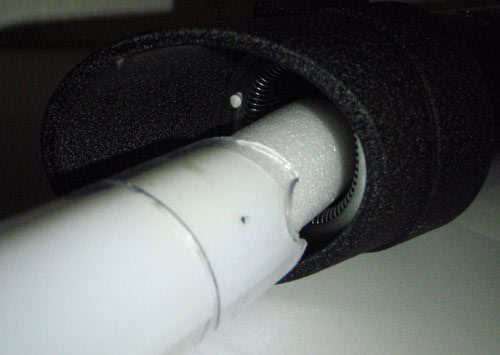
(I really am getting to my point :)) With the destruction of our FX lightsabers, I began searching for a way to repair our FX lightsabers with a blade engineered to withstand the force of many blows and abuse. My quest led me to a world I never even imagined existed, where Star Wars enthusiasts actively build and battle with what they create. These lightsaber ‘battle blades’ can be constructed of everything from PVC piping, metal plumbing parts, to finely machined pieces of aluminum. The electronics within also ranges in complexity and quality from the very simple to the incredibly complex. The Custom Saber Shop has the best materials and instruction forums currently available (I would like give a huge thanks to Bryan Alford for answering all my technical questions and Tim Yaskus (owner of The Custom Saber Shop) for answering all my parts availability questions).
The Hilt
The Custom Saber Shop is for everyone….from the noob to the most expert saber-smith. For the newbies, the owner of the website has created a very helpful/slick tool (called the Modular Hilt System (MHS) saber builder) which allows you to virtually create your lightsaber. My son and I worked together to design our lightsabers….it was a great deal of fun.
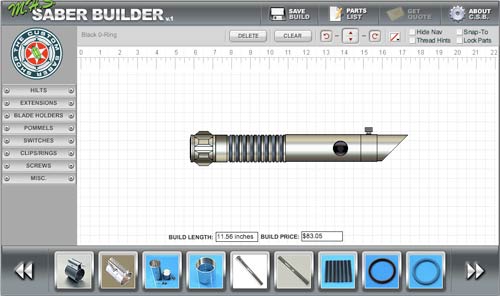
It is great being able to see your lightsaber/creation before ordering all the pieces.


When you are done designing your lightsaber you can save a graphic of the hilt you designed onto your computer. The top one is the Gadgeteer Kids and the bottom is mine.
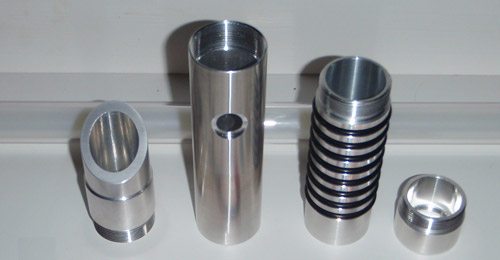
The basic hilt is comprised of three main pieces; the blade holder, center section, and pommel. But you can add various extensions and exterior facades to make your lightsaber hilt look as complicated or simplistic as you wish.

The Electronics
The electronics is where the real hands-on experience begins. As I mentioned earlier, you can make the electronics as simplistic (on and off) or complicated (FX sounds and blade flash) as you like. As my first attempt at saber-smithing, I decided to keep my electronics relatively basic.

As you can see from this line diagram from the The Custom Saber Shop, there are five pieces that make up the hilt electronics; the LED assembly, heat sink, some type of resistor, on/off switch, and battery holder.

The LED is the heart of the lightsaber. Depending on how bright you want your blade, they range in power from 1 watt to 5 watts. They come in a variety of colors dependent of which type of LED you choose.
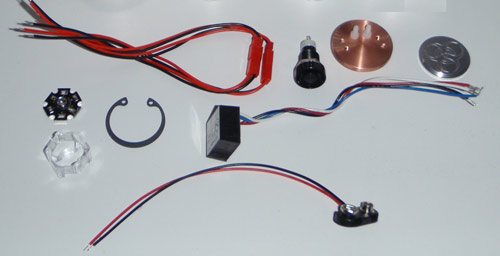
The Custom Saber Shop sells ‘electronics kits‘ that make it easy for you to receive all the correct pieces. Definitely a benefit to us noobs…. Because it is very easy to order the incorrect part(s).
The Battle Blade
The blade is made of a clear, thick and very durable polycarbonate (think schedule 40 PVC) pipe. The interior of the blade is coated to diffuses the LED light. There are two types of blades; a Corbin style and a TCSS style blades in two thicknesses ‘show’ or ‘battle’. You can buy the materials to create your own blades or order complete pre-made blades. The blades can be ordered in a variety of lengths between 24 and 40 inches. We chose pre-made 34″ TCSS battle blades.
The blade slides into the blade holder (top of the hilt) and is held in place by a blade retention screw. Since I do not have the tools to punch the threaded hole in the blade holder, I had Tim do that for me. But if I create another lightsaber, I will give it a try myself.
Bringing the Parts Together
The Forums on The Custom Saber Shop are an invaluable resource for noobs to learn the basics of saber-smithing. Once you figure out what parts you want/need and get the electronics connected/operational, combining all the pieces of the lightsaber was relatively easy.

Even unlit, the lightsabers are impressively well made and ballanced.
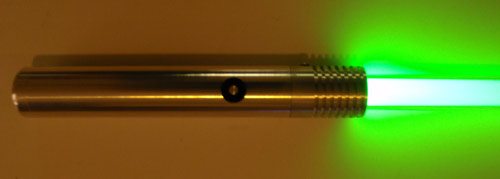
And once lit, they are even more impressive. The LED’s do a great job illuminating the blade.

Doing Battle
The next best part of creating your very own (ultra high quality, one of a kind) lightsaber, is doing battle with it.
The Gadgeteer Kid and I spend hours per week fighting against each other with our handmade lightsabers. And I can not tell you how much time per day he dedicates to practicing his ‘moves’. He will watch one of the movie battles and work for hours perfecting the their Jedi techniques.
The Cost
I have to admit, this project was expensive. I chose to upgrade several electrical components, buy pre-made blades, and had Tim tap the blade retention screw holes, all of which added extra cost. The overall cost was approximately $175 per lightsaber, which is more than double the price of a FX lightsaber now available from Hasbro. While the FX lightsabers have cool sound effects, they are not as bright or battle worthy as what you can create from The Custom Saber Shop. Also, if you add the electronics for sound and blade flash it could easily exceed $400.

Conclusions
The Gadgeteer Kid and I had an INCREDIBLY great time on this project, start to finish. We have created something that we will use/play with for years to come and potentially pass onto his kids decades from now. It was a great father/son experience and a memory I will cherish.
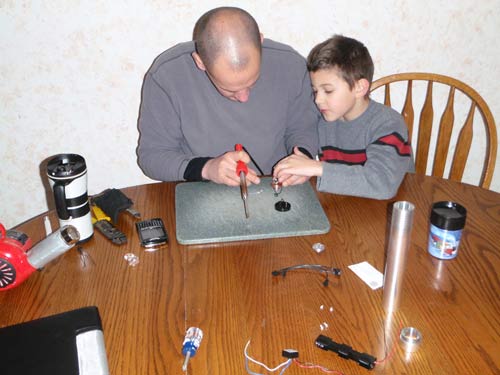
Whether you are an old or young Star Wars fan that always wanted the ultimate lightsaber, I highly recommend visiting The Custom Saber Shop, if for no other reason than to tempt yourself.
May the Force be with you….
Star Wars: Young Jedi Adventures Kai Brightstar Green Extendable Lightsaber, Toys, Preschool Toys for 3 Year Old Boys & Girls
Gerber Gear EVO Jr. Folding Knife - Serrated Edge [22-41493]
$28.99 (as of October 30, 2025 19:31 GMT -04:00 - More infoProduct prices and availability are accurate as of the date/time indicated and are subject to change. Any price and availability information displayed on [relevant Amazon Site(s), as applicable] at the time of purchase will apply to the purchase of this product.)Product Information
| Price: | Variable (cost as tested/designed was $175 for the Gadgeteer Kid's and $200 for mine) |
| Manufacturer: | The Custom Saber Shop |
| Pros: |
|
| Cons: |
|



Gadgeteer Comment Policy - Please read before commenting
Ace!
I waaaaannnntt one!
Hours of fun with mates guaranteed! Bit pricey tho…
Dan
I have to disagree with you.
I Don’t like TCSS
allot of the members were very very harassing towards me on the forum because i didn’t agree with someone’s opinion on a rivalling saber technology company.
I repeatedly told them to Stop bringing it up, but they persisted and upped the vulgarity, till i retaliated by unleashing the horrors of Japanese shock imagery because it was just escalating to disgusting levels of vulgar abuse and pestering over something that wasn’t a big deal in the first place (Everyone is entitled to their own opinion, and just because the person in question was a founding member doesn’t mean i should have his view on Hyperdyne forced upon me)
Nice you two had fun building your sabers at least.
you can allways convert the MR sabers, or put the MR soundboards in them did you know about that?
With some lessons you could end up like this:
http://www.youtube.com/watch?v=6jhDOPblXcA&eurl=http://the-gadgeteer.com/2009/02/16/my-lightsaber-saga/&feature=player_embedded
would even be less dangerous as with real swords and just as much fun.
😉
(… kids, don’t try this at home ! …)
ThePhantomMenace,
I agree, that some on the TCSS are a bit much…. But overall, the TCSS forums are a good place for newbies to begin learning about saber-smithing.
Yes, I have heard of modifying a MR saber or stealing parts from a broken one. We might give that a try as a future project.
Dave
I was looking at other YouTube lightsaber videos and came across several Saber Forge videos. I might have to try one of these. If for no other reason as to compare it to our TCSS creations. Plus it’ll allow me to try adding a Hasbro soundbroad 🙂 And if you go to the Saber Forge website, you can see that their lightsabers are expensive as well (esp if you have them add electronics and sound).
Very, very cool job, guys. It’s really cool to see a father and son work together and share their love of “Star Wars.” My dad doesn’t even know what “Star Wars” is!
Have you seen those fx lightsabers they have? They have motion sensors in them as well. Probably more for the faint of heart since this is much more involved. However the pay off is worth it, since you can say YOU BUILT YOUR OWN LIGHTSABER!!!
FYI, to use those expensive lightsabers, and if you’re in NYC, check out New York Jedi..they teach you how to fight with them!! Amazing videos of their techniques.
http://www.newyorkjedi.com/
I’ve already built a hilt. I just want to make mine hold the blade. Heading over there now to see if they can make it do that.
OH, and i hope you two had as much fun as i want to have
“It was a great father/son experience” … congratulations … it was the best part for me.